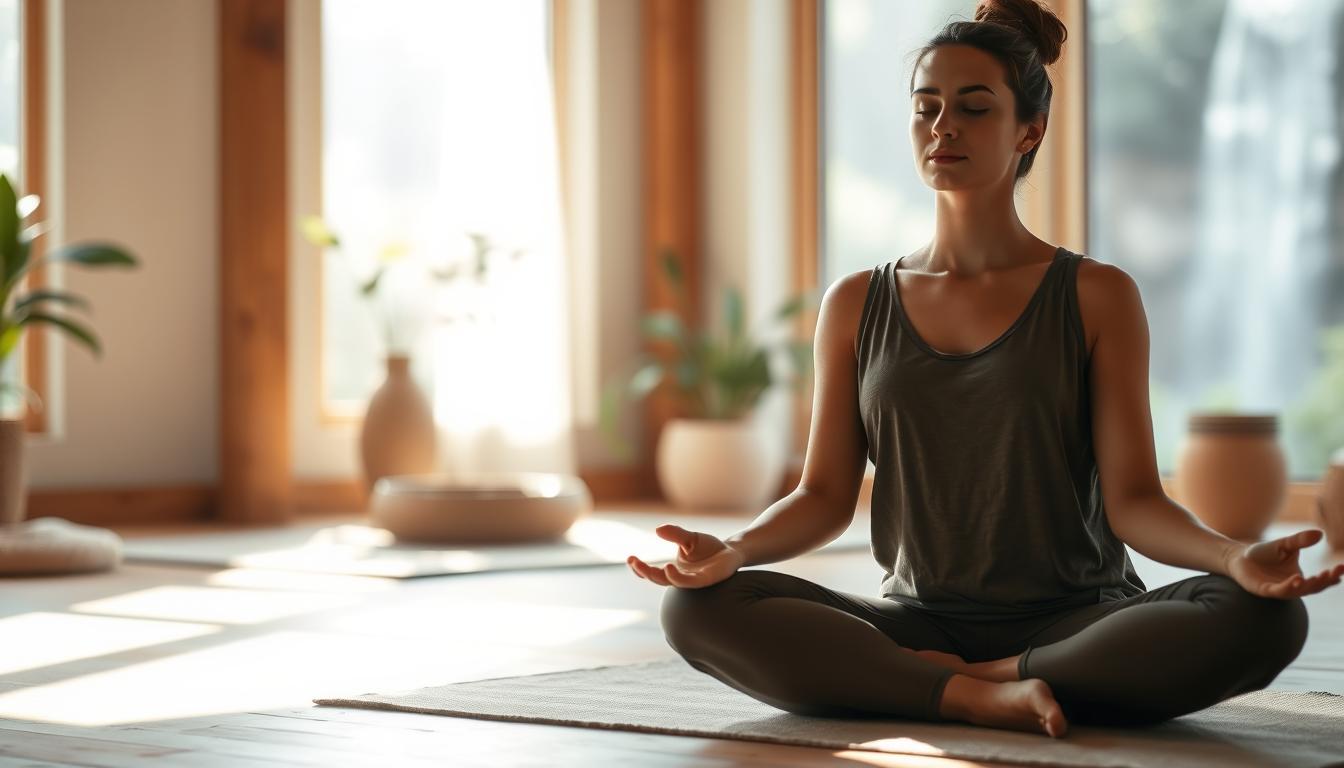I’ve been there – feeling overwhelmed by life’s demands and searching for a way to quiet my racing thoughts and find some peace in the chaos. Stress can be overwhelming, but I’ve found that meditation can be a powerful tool to combat it.
Meditation is a simple practice that can help you increase awareness of yourself and your surroundings. As a result, you can develop concentration and reduce stress, leading to better overall health. Through mindfulness meditation, you can cultivate a positive mood and outlook, even in the midst of chaos.
In this article, I’ll walk you through various guided meditation techniques to help you manage stress and find calm.
Key Takeaways
- Learn various guided meditation techniques to combat stress
- Understand the science behind why meditation works for stress management
- Discover accessible techniques to start implementing today
- Find a toolkit of guided meditation practices to help you find calm
- Improve your overall health through mindfulness meditation
Understanding Stress and Its Impact on Your Health
Stress is an inevitable part of modern life, affecting our overall well-being in profound ways. I’ve come to realize that it’s not just about feeling overwhelmed; it’s about how our body responds to the pressures of daily life.
When we’re under stress, our body’s “fight or flight” response is triggered, releasing hormones like cortisol and adrenaline into our bloodstream. This natural response is meant to be a temporary measure, but when it becomes chronic, it can have serious consequences.
How Chronic Stress Affects Your Body and Mind
Chronic stress can lead to a host of health issues, from cardiovascular problems to a weakened immune system. It’s fascinating – and a bit unsettling – to consider how our bodies respond to modern stressors much like they would to ancient threats, highlighting the need for effective stress management techniques.
The Science Behind Stress Hormones
Research has shown that cortisol, often called the “stress hormone,” affects nearly every system in your body, from your cardiovascular system to your digestive tract. Understanding the role of cortisol and other stress hormones can help us better manage stress and its impact on our overall health.
The Benefits of Meditation for Stress Management
Research has consistently demonstrated that meditation can have a significant impact on reducing stress levels. By incorporating meditation into your daily routine, you can experience a range of benefits that improve both your mental and physical well-being.
Activating the Parasympathetic Nervous System
Meditation works by activating the parasympathetic nervous system, which promotes relaxation and reduces stress. When we’re stressed, our body’s “fight or flight” response is triggered, releasing stress hormones like cortisol. Regular meditation practice helps to counterbalance this response, promoting a sense of calm and relaxation.
Research-Backed Evidence
Numerous studies have investigated the effects of meditation on stress reduction. According to research from the University of California, Davis, people who used generalized meditation programs had lower levels of cortisol. A 2018 study found that medical students who used a meditation app for just 10 days experienced a 12% decrease in stress; and a separate study found that people who used the app for 30 days reduced stress by a third.
| Meditation Style | Stress Reduction | Duration |
|---|---|---|
| Mindfulness Meditation | Significant reduction | 8 weeks |
| Loving-Kindness Meditation | Positive effects | Varied |
| Focused-Attention Meditation | Reduced stress | 10 days |
The benefits of meditation for stress management are clear. By incorporating mindfulness meditation or other styles into your daily routine, you can experience significant reductions in stress and improvements in overall well-being. As research continues to uncover the benefits of meditation, it’s becoming increasingly clear that this practice is a valuable tool for managing stress in today’s fast-paced world.
Getting Started with Guided Meditation
Starting your meditation practice doesn’t have to be overwhelming; it’s about taking that first step. To make meditation a habit, it’s best to start with a simple practice that you can incorporate into your daily routine over time.
As you begin, you’ll find that consistency is key. You can start with just a few minutes a day and gradually increase the duration as you become more comfortable with the practice.
Creating the Right Environment
To begin, find a quiet and comfortable space where you can meditate without distractions. This will help you establish a consistent practice and make the most of your time.
Setting Realistic Expectations
One of the biggest mistakes people make when starting meditation is expecting immediate results. Instead, set small, achievable goals, like meditating three times a week for five minutes. Progress in meditation isn’t linear – some days will be calm, while others will be chaotic.
| Tips for Beginners | Description |
|---|---|
| Start Small | Begin with short sessions (5-10 minutes) and gradually increase time. |
| Be Consistent | Aim to meditate at the same time daily to build a habit. |
| Track Progress | Use a habit tracker app to monitor your meditation practice. |

Focused-Attention Meditation Techniques for Stress Relief

By concentrating on a single object, thought, or sound, focused-attention meditation helps calm the mind and reduce stress. This style of meditation emphasizes ridding your mind of distractions, allowing you to focus on what’s truly important.
Breath-Focused Meditation
One of the simplest forms of focused-attention meditation is breath-focused meditation. By concentrating on your breath, you can calm your mind and reduce stress. When your mind starts to wander, gently bring your attention back to your breath without judgment.
Mantra and Sound-Based Meditation
When breath-focused meditation feels challenging, I often turn to mantra meditation – repeating a word or phrase that helps anchor your attention. Your mantra can be anything that resonates with you – traditional options like “om” or simple phrases like “peace” or “calm” work well. For more information on the benefits of meditation, you can visit Mayo Clinic’s meditation resources. What I appreciate about mantra meditation is how it gives my verbal mind something to do, which can be particularly helpful if you have a chatty inner dialogue.
Sound-based meditation might involve focusing on ambient sounds in your environment or using tools like singing bowls or meditation apps with calming tones. These techniques create a rhythmic focus that many people find easier to maintain than breath awareness, especially when the mind is particularly active.
Open-Monitoring Meditation Approaches to Reduce Anxiety

Open-monitoring meditation encourages a non-judgmental awareness of the present moment, helping to alleviate anxiety. This practice involves broadening your awareness to all aspects of your environment, thoughts, and sense of self. By doing so, you may become aware of suppressed thoughts, feelings, or impulses that contribute to your anxiety.
Mindfulness Meditation Practice
Mindfulness meditation is a form of open-monitoring meditation that focuses on being present in the moment. It’s about observing your thoughts, feelings, and bodily sensations without judgment. Regular practice can lead to increased awareness of your mental and physical states, helping you manage anxiety more effectively.
Body Scan Meditation Technique
The body scan meditation is a technique that involves systematically bringing awareness to different parts of your body, from toes to head. This practice helps identify and release physical tension often associated with anxiety. By focusing on physical sensations, you can create a powerful mind-body connection, recognizing early signs of anxiety before they escalate.
Through meditation, particularly open-monitoring techniques, you can develop a greater understanding of your anxiety and learn to manage it more effectively. Regular practice can lead to a significant reduction in anxiety levels, promoting overall well-being.
Loving-Kindness Meditation for Emotional Balance

Loving-kindness meditation helps us cultivate compassion and understanding towards ourselves and others.
Through practice, people learn to extend kindness and forgiveness externally, first to friends, then to acquaintances, and ultimately to those we might consider enemies.
Developing Compassion Through Meditation
We start by developing self-compassion, using simple phrases like “May I be happy, may I be healthy, may I live with ease.”
This practice helps us establish a foundation of kindness towards ourselves.
Extending Compassion to Others
As we progress, we extend this compassion to others, beginning with those we care about, then moving to neutral people, difficult relationships, and eventually all beings.
Research has shown that regularly practicing compassion meditation changes how we respond to others’ suffering, increasing both empathic concern and helping behavior.
Short Guided Meditations for Busy Schedules

With increasingly demanding schedules, people are turning to short guided meditations as an effective stress management tool. I’ve found that even a few minutes of meditation can make a significant difference in how I feel throughout the day.
5-Minute Morning Meditation Routines
Starting your day with a short meditation routine can set a positive tone. Set a time limit, especially if you’re just starting out – it can be five or ten minutes. This simple practice helps in creating a sense of calm before diving into the day’s tasks.
Midday Stress-Relief Meditation Breaks
Many people experience an afternoon energy slump around 2-3 PM, making it the perfect time for a brief meditation to refresh your mind. I’ve found that short midday meditation breaks are like hitting the reset button when stress starts to accumulate – even 3-5 minutes can help clear mental fog.
These brief pauses are particularly effective because they interrupt the stress cycle before it builds to overwhelming levels. I like to think of these short breaks as “mental hygiene” – just as we wouldn’t go all day without washing our hands, we shouldn’t go all day without clearing our minds.
Guided Meditation Apps and Resources

For those new to meditation, using guided meditation apps can be a great way to get started. Many people who meditate regularly have learned to condition their body to relax on demand, and, according to research, can more effectively manage stress.
Top-Rated Meditation Apps for Beginners
When it comes to choosing a meditation app, there are several top-rated options for beginners. While some apps require a subscription, there are also excellent free resources available. The Insight Timer app, for instance, offers thousands of free guided meditations from various teachers, making it a great starting point.
Free Online Guided Meditation Resources
Not everyone wants to pay for a meditation app, and fortunately, there are excellent free resources available. YouTube channels like “Yoga with Adriene” and “The Honest Guys” offer quality guided meditations. Additionally, university wellness centers often provide free meditation recordings on their websites – UCLA’s Mindful Awareness Research Center has an excellent collection. Public libraries also increasingly offer free access to meditation apps through their digital resources.
Incorporating Meditation into Your Daily Routine
As someone who’s experienced the benefits firsthand, I can attest that making meditation a daily habit is a simple yet effective way to reduce stress. Many people who meditate regularly have learned to condition their body to relax on demand, and, according to research, can more effectively manage stress.
To make meditation a sustainable part of your daily routine, it’s essential to create a consistent practice. This involves setting aside a dedicated time and space for meditation, free from distractions.
Creating a Sustainable Meditation Practice
Start by committing to a realistic daily meditation goal, even if it’s just a few minutes a day. Consistency is key to developing a long-term habit. You can begin with short guided meditations and gradually increase the duration as you become more comfortable with the practice.
Combining Meditation with Other Stress-Management Techniques
Meditation works best as part of a comprehensive stress-management toolkit. Combining it with physical exercise amplifies the benefits of both practices. Regular meditation also creates a foundation of mindfulness that enhances other stress-reduction techniques like deep breathing, progressive muscle relaxation, or journaling. You can even blend meditation with daily activities like walking or eating, making it a seamless part of your daily life.

By incorporating meditation into your daily routine and combining it with other stress-management techniques, you can develop a more resilient response to stress and improve your overall well-being.
Conclusion: Embracing the Journey to Stress-Free Living
The journey to stress-free living through meditation is not only achievable but also accessible to everyone. By incorporating meditation into your daily routine, you can experience significant health benefits, including improved emotional regulation and better sleep quality. Meditation may help transform your relationship with stress and also improve your overall well-being. For more insights on the benefits of mindfulness meditation, you can explore resources like this article. Embracing meditation can lead to a more balanced life.
FAQ
How does guided meditation help with stress?
Guided meditation helps with stress by activating the parasympathetic nervous system, which promotes relaxation and reduces stress hormones like cortisol. Regular practice can lead to a decrease in anxiety and an overall sense of calm.
What is the best time of day to practice guided meditation?
The best time to practice guided meditation is whenever it fits into your schedule. Many people find that starting the day with a morning meditation session helps set a positive tone, while others prefer to use it as a midday stress-relief break.
Can guided meditation help with anxiety and depression?
Yes, guided meditation can be a helpful tool in managing anxiety and depression. By promoting relaxation and reducing stress, it can help alleviate symptoms. However, it’s essential to consult with a healthcare professional for a comprehensive treatment plan.
How long should I meditate to see results?
Even a few minutes of guided meditation a day can be beneficial. Research suggests that regular practice, ideally 10-20 minutes per session, can lead to noticeable improvements in stress levels and overall well-being.
Do I need to be experienced in meditation to use guided meditation apps?
No, you don’t need prior experience with meditation to use guided meditation apps. Many apps are designed for beginners, offering gentle introductions to various techniques and styles to help you get started.
Can I combine guided meditation with other stress-management techniques?
Absolutely. Guided meditation can be used in conjunction with other stress-management techniques, such as yoga, deep breathing, or journaling, to create a comprehensive self-care routine that suits your needs.
Will guided meditation help improve my sleep?
Yes, guided meditation can help improve sleep quality by promoting relaxation and reducing stress. Practicing guided meditation before bed can be particularly helpful in preparing your body for a restful night’s sleep.
